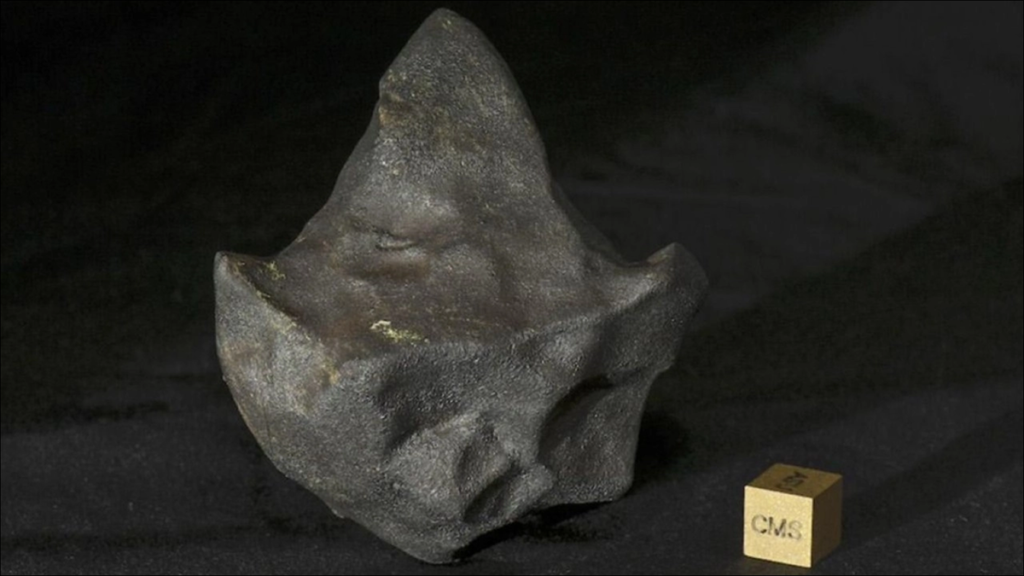The pieces of a meteorite that fell in Costa Rica in 2019 are so unusual that scientists believe it had moved through space relatively unscathed — that is, until it encountered our planet. This is in stark contrast to other typical meteorites that show the wounds of having been in numerous collisions before reaching Earth.
The meteorites were recovered from near the Costa Rican town of Aguas Zarcas, and are of a type referred to as ‘mudballs’, in the sense that they contain water-rich minerals.
The findings have resulted in a reappraisal of these so-called mudball meteorites. It had been assumed that their high content of water-rich minerals would make them structurally weaker than other types of meteorites, rendering them more susceptible to damage or burning. But, “Apparently, [the presence of water-rich minerals] … does not mean they are weak,” said Peter Jenniskens, a meteor astronomer from the SETI Institute and NASA Ames Research Center in California, in a statement.
Scientists say the discovery rivals one of the largest discoveries of meteorites nearly 50 years prior. “Twenty-seven kilograms [60lbs] of rocks were recovered, making this the largest fall of its kind since similar meteorites fell near Murchison in Australia in 1969,” said Jenniskens.
The Murchison meteorite fall occurred just two months after the Apollo 11 mission. The recovered pieces showed that evidence of having been altered by liquid water on its parent body before an impact smashed apart that parent body and sent the Murchison and, later, the Aguas Zarcas meteoroids spinning into space. (Meteoroids are what we call meteorites when they are in space.)
Video camera footage shows the 2019 mudball meteor entering the atmosphere from the west-north-west direction over Costa Rica at a steep, almost vertical angle of 81 degrees, and at a velocity of 9 miles (14.6 kilometers) per second. This steep angle allowed the meteor passed through less of Earth’s atmosphere than it would have if it had approached on a shallower angle. That means more of the original meteoroid survived the fiery passage through the sky above Costa Rica.
Based on the incoming meteor’s trajectory, “We can tell that this object came from a larger asteroid low in the asteroid belt, likely from its outer regions,” said Jenniskens.
As it entered Earth’s atmosphere, the rocky body is estimated to have been about 23.6 inches (60 centimeters) across. Friction with the atmosphere generated heat that melted its surface, stripping away much of the rock in a process known as ablation as it began to burn up.
“It penetrated deep into Earth’s atmosphere, until the surviving mass shattered at 15.5 miles (25 kilometers) above the Earth’s surface, where it produced a bright flash that was detected by satellites in orbit,” said Jenniskens.
Those satellites were the Geostationary Operational Environment Satellites (GOES) 16 and 17 and their lightning detectors, which are Earth-observing satellites operated by NASA and the National Oceanic and Atmospheric Administration (NOAO).
The fragments scattered themselves across the soft ground of Costa Rican jungle and grasslands, where they were subsequently found by meteorite hunters and volunteers. But the meteorites had a slightly unusual appearance.
“The Aguas Zarcas fall produced an amazing selection of fusion-crusted stones with a wide range of shapes,” said meteor scientist Laurence Garvie of the Buseck Center for Meteorite Studies at Arizona State University. “Some stones have a beautiful blue iridescence to the fusion crust.”
The fusion crust is the glassy, melted surface of a meteorite after it has endured ablation.
Usually, meteorites have some flat sides, where they have broken apart as the result of stress fractures in the original meteoroid that were placed there by collisions in space with other meteoroids. The rounded rather than flat shapes of the Aguas Zarcas meteorites suggested that the meteoroid had travelled through space relatively unscathed after being blasted off its parent body.

It has even been possible to calculate how long ago that was. Exposure to cosmic rays alters the composition of a meteoroid, so the degree of alteration tells us how long a meteoroid has been in space after breaking off its parent body.
“The last collision experienced by this rock was two million years ago,” said cosmochemist Kees Welton of UC Berkeley, who led this part of the study.
“After getting loose, it took two million years to hit the tiny target of Earth, all the time avoiding getting cracked,” added Jenniskens. This seems surprisingly recent, given the 4.6-billion-year history of the solar system.
“We know of other Murchison-like meteorites that broke off at approximately the same time [as Murchison], and likely in the same event, but most broke much more recently,” said Welton, with the Aguas Zarcas meteorites exemplifying the point.
Perhaps it is appropriate that the last word goes to Gerado Soto of the University of Costa Rica in San José, who draws similarities with the Murchison meteorite fall and its closeness in time to Apollo 11.
“The fall of Aguas Zarcas was huge news in the country. No other fireball was as widely reported and then recovered as stones on the ground in Costa Rica in the past 150 years,” he said. “The recovery of Aguas Zarcas [meteorites], too, was a small step for man, but a giant leap in meteoritics.”
The findings were published on March 29 in the journal Meteoritics & Planetary Science.
Originally posted on Space.com.
